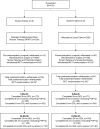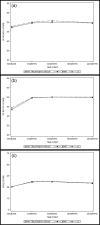Perioperative Behavioral Therapy and Pelvic Muscle Strengthening Do Not Enhance Quality of Life After Pelvic Surgery: Secondary Report of a Randomized Controlled Trial
- PMID: 29077924
- PMCID: PMC6075557
- DOI: 10.1093/ptj/pzx077
Perioperative Behavioral Therapy and Pelvic Muscle Strengthening Do Not Enhance Quality of Life After Pelvic Surgery: Secondary Report of a Randomized Controlled Trial
Abstract
Background: There is significant need for trials evaluating the long-term effectiveness of a rigorous program of perioperative behavioral therapy with pelvic floor muscle training (BPMT) in women undergoing transvaginal reconstructive surgery for prolapse.
Objective: The purpose of this study was to evaluate the effect of perioperative BPMT on health-related quality of life (HRQOL) and sexual function following vaginal surgery for pelvic organ prolapse (POP) and stress urinary incontinence (SUI).
Design: This study is a secondary report of a 2 × 2 factorial randomized controlled trial.
Setting: This study was a multicenter trial.
Participants: Participants were adult women with stage 2-4 POP and SUI.
Intervention: Perioperative BPMT versus usual care and sacrospinous ligament fixation (SSLF) versus uterosacral ligament suspension (ULS) were provided.
Measurements: Participants undergoing transvaginal surgery (SSLF or ULS for POP and a midurethral sling for SUI) received usual care or five perioperative BPMT visits. The primary outcome was change in body image and in Pelvic Floor Impact Questionnaire (PFIQ) short-form subscale, 36-item Short-Form Health Survey (SF-36), Pelvic Organ Prolapse-Urinary Incontinence Sexual Questionnaire short form (PISQ-12), Patient Global Impression of Improvement (PGII), and Brink scores.
Results: The 374 participants were randomized to BPMT (n = 186) and usual care (n = 188). Outcomes were available for 137 (74%) of BPMT participants and 146 (78%) of the usual care participants at 24 months. There were no statistically significant differences between groups in PFIQ, SF-36, PGII, PISQ-12, or body image scale measures.
Limitations: The clinicians providing BPMT had variable expertise. Findings might not apply to vaginal prolapse procedures without slings or abdominal apical prolapse procedures.
Conclusions: Perioperative BPMT performed as an adjunct to vaginal surgery for POP and SUI provided no additional improvement in QOL or sexual function compared with usual care.
© 2017 American Physical Therapy Association
Figures



References
-
- Li C, Gong Y, Wang B. The efficacy of pelvic floor muscle training for pelvic organ prolapse: a systematic review and meta-analysis. Int Urogynecol J. 2016;27:981–992. - PubMed
-
- Hagen S, Stark D. Conservative prevention and management of pelvic organ prolapse in women. Cochrane Database Syst Rev. 2011;12:CD003882. - PubMed
-
- Braekken IH, Majida M, Engh ME, Bo K. Can pelvic floor muscle training reverse pelvic organ prolapse and reduce prolapse symptoms? An assessor-blinded, randomized, controlled trial. Am J Obstet Gynecol. 2010;203:170e1–170.e7. - PubMed
-
- Dumoulin C, Hay-Smith J. Pelvic floor muscle training versus no treatment, or inactive control treatments, for urinary incontinence in women. Cochrane Database Syst Rev. 2010;1:CD005654. - PubMed
-
- Lakeman MM, Koops SE, Berghmans BC, Roovers JP. Peri-operative physiotherapy to prevent recurrent symptoms and treatment following prolapse surgery: supported by evidence or not? Int Urogynecol J. 2013;24:371–375. - PubMed
Publication types
MeSH terms
Grants and funding
LinkOut - more resources
Full Text Sources
Other Literature Sources
Medical

